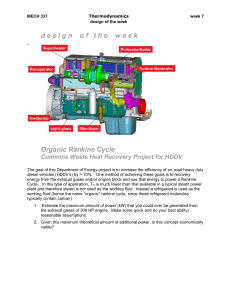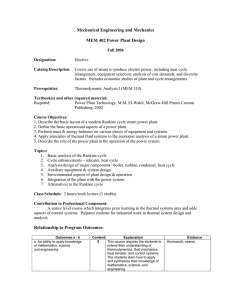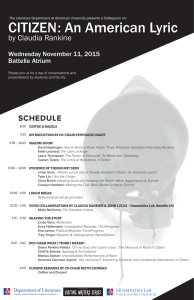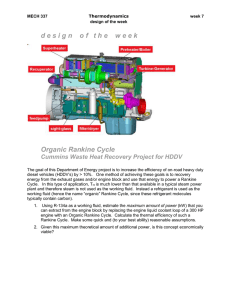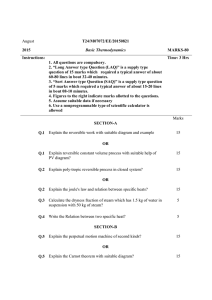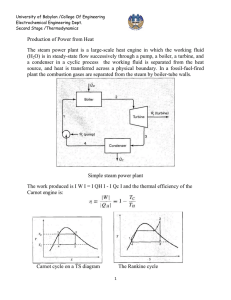Department of Electronics and Electrical Engineering
advertisement
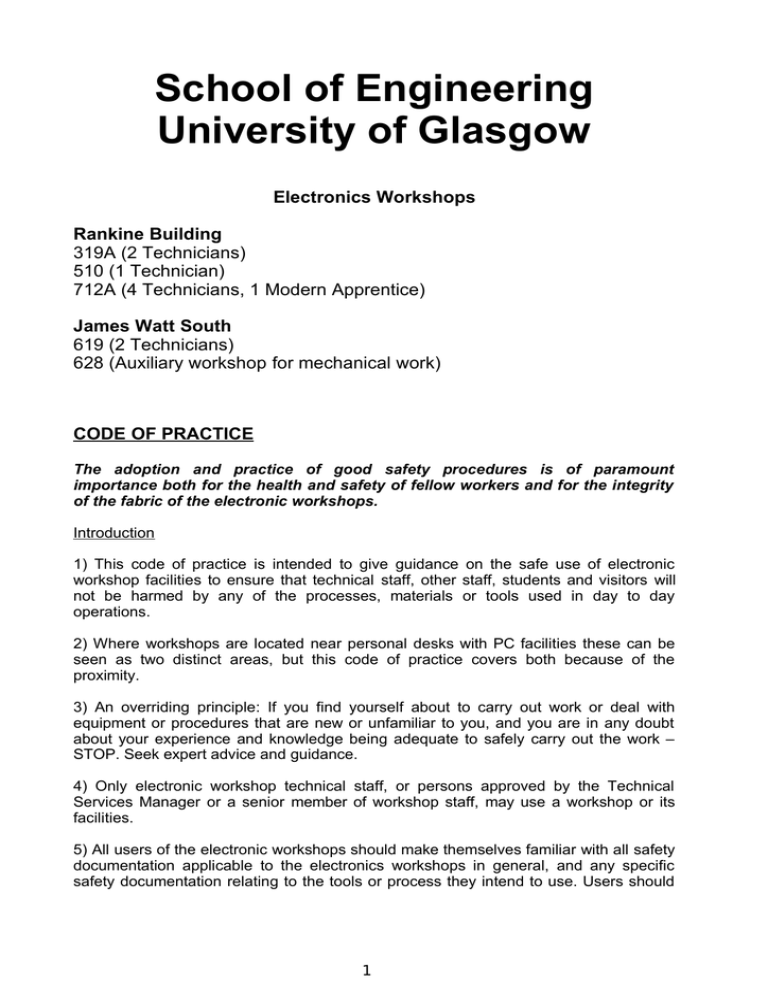
School of Engineering University of Glasgow Electronics Workshops Rankine Building 319A (2 Technicians) 510 (1 Technician) 712A (4 Technicians, 1 Modern Apprentice) James Watt South 619 (2 Technicians) 628 (Auxiliary workshop for mechanical work) CODE OF PRACTICE The adoption and practice of good safety procedures is of paramount importance both for the health and safety of fellow workers and for the integrity of the fabric of the electronic workshops. Introduction 1) This code of practice is intended to give guidance on the safe use of electronic workshop facilities to ensure that technical staff, other staff, students and visitors will not be harmed by any of the processes, materials or tools used in day to day operations. 2) Where workshops are located near personal desks with PC facilities these can be seen as two distinct areas, but this code of practice covers both because of the proximity. 3) An overriding principle: If you find yourself about to carry out work or deal with equipment or procedures that are new or unfamiliar to you, and you are in any doubt about your experience and knowledge being adequate to safely carry out the work – STOP. Seek expert advice and guidance. 4) Only electronic workshop technical staff, or persons approved by the Technical Services Manager or a senior member of workshop staff, may use a workshop or its facilities. 5) All users of the electronic workshops should make themselves familiar with all safety documentation applicable to the electronics workshops in general, and any specific safety documentation relating to the tools or process they intend to use. Users should 1 familiarise themselves with emergency exit routes and positions of safety equipment such as mains isolators, fire extinguishers and first aid kits. 6) Work outside normal hours (9am - 5pm) should only be undertaken with the agreement of the Technical Services Manager. Emergency telephone number: 4444. Signage showing Emergency exit routes from Electronics Workshops is beside entrance doors. Fire Extinguishers: Rankine 319A: in workshop Rankine 510: in adjacent lab, 509 Rankine 712A: in workshop JWS 619: in workshop JWS 628: in workshop Remember to use only CO2 extinguishers for electrical fires. Emergency Eye Irrigation bottles: Rankine 712A: in workshop and in PCB room (Rankine 715) First Aid kit: Rankine 319A: in adjacent lab, Rankine 327A Rankine 510: in adjacent lab, Rankine 509 Rankine 712A: in workshop JWS 619: in JWS 620 (Teaching Office) JWS 628: in JWS 620 (Teaching Office) General Housekeeping 1) Work areas, machines, personal desks and surrounding floor space should be kept clean and tidy with no trailing cables. Tools should be stored after use in the appropriate tool cupboards or personal toolboxes. Passages should be kept clear of clutter and combustible materials such as cardboard boxes or delivery crates. 2) All materials and chemicals should be stored safely with reference to specific dangers, hazards or toxicities published in the relevant material safety data sheets. Fridges designated for storage of chemicals or solder pastes should be marked as such and must not be used to store food or drink. 3) Waste materials should be disposed of appropriately, i.e. All electrical items must go through the WEEE (waste electrical and electronic equipment) process, batteries in the marked recycling containers in the Electronics Store, paper, plastic and cans in the local recycling containers. Chemicals must be disposed of in accordance with instructions in the relevant material safety data sheets. 4) Food and drink must not be consumed near or within work or chemical process areas to prevent risk of electric shocks (liquid spillage), poisoning or distraction of others. 2 Electricity 1) When working on any equipment or process that requires exposed voltages greater than 50V do a risk assessment and only proceed once all hazards have been assessed and controls put in place. A minimum control in this situation is the designation of two additional competent persons to be present to monitor your safety and render assistance or raise the alarm should you be injured. Additionally, if mains supply voltage is involved, this must come from an RCD protected socket or isolation transformer. A simple means of supply disconnection in an emergency must be available. 2) Design, construction, connection, modification, safety assessment and testing of mains powered or high voltage sections of equipment must only be carried out by those who are approved by the Technical Services Manager as having the relevant competency and experience. This work must still comply with code 1) above. 3) All electrical equipment that has been designed, manufactured or repaired in the Electronics workshops must be assessed for electrical safety and tested where appropriate and safety labeled before being put into service. It is good practice when assessing the electrical safety of newly built or rewired equipment to get the work validated by a colleague with appropriate competency before releasing the item to staff or students. 4) Many sources of electricity will give sufficient current under fault conditions to cause overheating and fire. Ensure that any source of electrical energy has current limiting, fuses or similar protection appropriate for the connected equipment. Battery supplies are always live and many can supply sufficient current to cause a fire, even if the voltages involved are considered safe to handle. Where this danger exists the supply from the battery must be fused as close to the terminals as possible or resettable circuit breakers used in the same position. Machine Tools Such as pillar drills, sanders, routing/milling machines etc. 1) Familiarise yourself with the location of emergency isolating switches for the machine tools in your area. 2) You must only work with machine tools for which you have had training or can demonstrate that you have the experience and competency to use safely. 3) Only use machine tools for their designed purpose. Do not make modifications or try to load work pieces that are too large or heavy or that cannot be safely clamped into position. 4) Always tie hair and loose clothing/jewellery back, tape or remove rings if there is a risk of catching, wear appropriate eye protection and protective clothing, and use provided safety measures such as chuck guards or covers. 5) Never operate machine tools when alone or defeat safety interlocks. 3 Handheld Power Tools 1) Mains powered hand tools such as hand drills, hot air guns, orbital sanders, soldering irons etc. must be inspected before use to identify frayed or damaged flexible leads, insecure lead clamping or cracked plugs/casings etc. If any damage is found they must not be used until repaired and safety tested. 2) A regular PAT inspection and testing schedule should be in place for all mains powered hand tools. 3) Always tie hair and loose clothing/jewellery back, tape or remove rings if there is a risk of catching, wear appropriate eye protection and protective clothing. 4) Be aware of the torque generated, even by battery powered cordless drills. Take care to have a secure grip and stance. Clamp the workpiece where necessary. Take extra care and precautions when working at heights. Hand Tools 1) Only use hand tools for their designed purpose. Modifying them or 'making do' by using the wrong tool for the job can lead to injury. 2) Wear appropriate eye protection and protective clothing to prevent injury from wire cuttings, slipping tools etc. 3) When soldering use local fume extraction equipment. Tie hair and loose items back to prevent burning. Wash hands after handling solder alloys and fluxes. Computers 1) Refer to 'A step-by-step guide to assessment of display screen equipment (DSE)' on the University of Glasgow SEPS website to check and adjust the setup of any desk, seating and PC you use in the electronic workshops. Chemical Processes 1) Where necessary chemical processes used during the manufacture of printed circuit boards should be carried out in accordance with any existing local risk assessment for this work. 2) The use, labeling and disposal of chemicals for printed circuit board manufacture must take into account the advice provided in the relevant material safety data sheets. 3) Wear suitable eye protection, gloves, face mask, protective clothing and footwear. 4) Use local extract ventilation and/or fume-hoods to remove harmful vapor. 4 Lifting, Moving and Working at Heights 1) Use PPE (personal protective equipment ) such as safety shoes, overalls/lab coats, eye protection for dust and particles from ceiling voids etc. 2) For working at heights use only properly designed step ladders or self assembly scaffolding that has current safety audit labeling and ensure another person is present to look after your safety. Where unusual or hazardous circumstances dictate, carry out a risk assessment. 3) Where a lift or move is judged to be out-with commonplace size or weight, or involves height, a risk assessment must be done and consideration given to the need for training, specialist advice/help or equipment. Accidents and Injuries 1) All accidents, injuries and dangerous occurrences (a near miss) must be reported promptly to the Technical Services Manager who will write an incident report for submission to SEPS (which must be done within a specified time limit). 5
